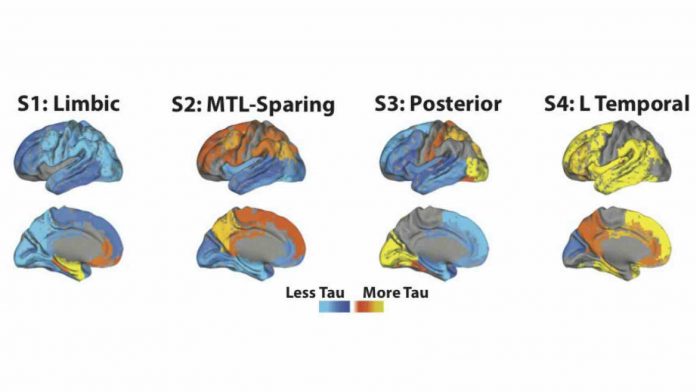Alzheimer’s disease is characterized by the abnormal accumulation and spread of the tau protein in the brain. An international study can now show how tau spreads according to four distinct patterns that lead to different symptoms with different prognoses of the affected individuals. The study was published in Nature Medicine.
“In contrast to how we have so far interpreted the spread of tau in the brain, these findings indicate that tau pathology in the brain varies according to at least four distinct patterns. This would suggest that Alzheimer’s is an even more heterogeneous disease than previously thought. We now have reason to reevaluate the concept of typical Alzheimer’s, and in the long run also the methods we use to assess the progression of the disease”, says Jacob Vogel from McGill University, and the lead author of the study.
The spread of tau in the cerebral cortex is a key marker for Alzheimer’s. In recent years, it has become possible to monitor the accumulation of the toxic protein in the brain of Alzheimer’s patients with the help of PET technology, an advanced medical imaging technique.
For the past thirty years, many researchers have described the development of tau pathology in Alzheimer’s using a single model, despite recurring cases that do not fit that model. However, the current findings explain why different patients may develop different symptoms.
“Because different regions of the brain are affected differently in the four subtypes of Alzheimer’s, patients develop different symptoms and also prognoses. This knowledge is important for doctors who assess patients with Alzheimer’s, and it also makes us wonder whether the four subtypes might respond differently to different treatments. Right now, research on various drugs that reduce the amount of tau in the brain is very active, and it will be exciting to see if they vary in efficacy depending on the subtype of Alzheimer”, says Oskar Hansson, professor of neurology at Lund University, who supervised the study.
The current study is a collaboration between sites in Sweden, Canada, USA and Korea. Together, the researchers have examined the largest and most diverse population in the world to date with tau-PET, which spans the entire clinical picture of Alzheimer’s disease. The study included participants who had not yet developed any symptoms, so-called pre-symptomatic Alzheimer’s, participants with mild memory difficulties and those with fully developed Alzheimer’s dementia.
In a first sample, long-term data was compiled from 1,612 individuals within five independent multicenter studies. Among these, the researchers identified a total of 1,143 individuals who were either cognitively normal or individuals who had developed Alzheimer’s in various stages.
An algorithm was applied to the data from the tau PET images from the 1,143 individuals, the so-called SuStaIn (Subtype and Staging Inference) algorithm. The material was processed with machine learning in an automated process, in order to be able to distinguish subtypes and patterns as impartially as possible.
As expected, many individuals did not show any abnormal tau PET signal, and these were therefore automatically assigned to a tau-negative group. By then cross-validating the tau PET images with a sixth independent cohort, and following up the individuals for about two years, the researchers were able to develop four patterns that best represented the data from the remaining individuals. Although the number of subgroups varied in relation to the individuals, all were represented in all cohorts.
“We identified four clear patterns of tau pathology that became distinct over time. The prevalence of the subgroups varied between 18 and 30 percent, which means that all these variants of Alzheimer’s are actually quite common and no single one dominates as we previously thought”, says Oskar Hansson.
“The varied and large databases of tau-PET that exist today, along with newly developed methods for machine learning that can be applied to large amounts of data made it possible for us to discover and characterize these four subtypes of Alzheimer’s. However, we need a longer follow-up study over five to ten years to be able to confirm the four patterns with even greater accuracy”, says Oskar Hansson.
The researchers believe that this new knowledge can give patients more individualized treatment methods in the future.








